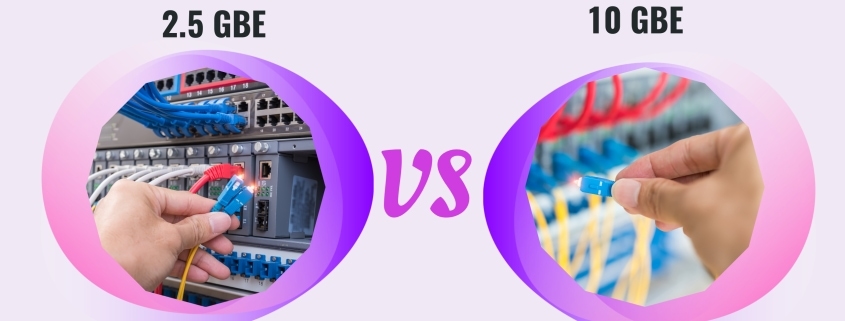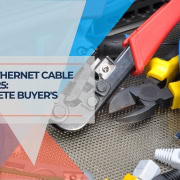2.5 Gigabit vs. 10 Gigabit: Why 2.5 Gbe Might Be the Best Choice for Your Network
If you're looking to upgrade your home or small business network, you've probably encountered the debate between 2.5 gigabit Ethernet and 10 gigabit Ethernet. Traditionally, 1 gigabit (1 Gbps) has been the standard, but 2.5 and 10 gigabits offer a serious boost in speed. 10 gigabit might seem like the obvious winner, but there's a strong case for 2.5 gigabit being the smarter, more practical choice for many.
Let's break down the pros and cons of each and figure out if 2.5 Gbe could be the unsung hero of your network upgrade.
Table of Contents
- 1 Key Takeaways
- 2 Real-World Performance: What the Numbers Actually Mean
- 3 Key Advantages of 2.5 Gigabit Ethernet
- 4 UniFi Switch Options: 2.5G vs 10G Implementation
- 5 When Does 10 Gigabit Make Sense?
- 6 WiFi 7 Access Points: The 2.5G Sweet Spot
- 7 Is 2.5 Gigabit Enough? Real-World Use Cases
- 8 Complete UniFi Network Scenarios
- 9 Expert Insight: Why 2.5G Often Makes Sense for Businesses
- 10 Essential Cables and Adapters
- 11 Implementation Strategy: Phased Approach
- 12 Additional Considerations
- 13 Conclusion
- 14 FAQ
- 15 Glossary
Key Takeaways
| Feature | 2.5 Gigabit | 10 Gigabit | What it Means |
|---|---|---|---|
| Speed | 2.5x faster | 10x faster | Significant boost vs. 1 Gbps, but 10G is overkill for most |
| Cost | $20-30 adapters | $150-200 adapters | Budget-friendly vs. Premium investment |
| Compatibility | Works with Cat5e | Often needs Cat6+ | May save you from rewiring your home/office |
| Power Draw | Lower | Higher | Cooler operation, better for mobile devices |
Real-World Performance: What the Numbers Actually Mean
Understanding theoretical speeds is one thing, but seeing how they translate to actual tasks helps put the performance difference into perspective:
| Task | 1 Gbps Time | 2.5 Gbps Time | 10 Gbps Time |
|---|---|---|---|
| 100GB file transfer | 13.3 minutes | 5.3 minutes | 1.3 minutes |
| 1TB backup to NAS | 2.2 hours | 53 minutes | 13 minutes |
| 4K video editing project (200GB) | 26.7 minutes | 10.7 minutes | 2.7 minutes |
Key Advantages of 2.5 Gigabit Ethernet
When it comes to upgrading your network, there are several compelling reasons to give 2.5 gigabit Ethernet serious consideration:
Cost-Effectiveness
Perhaps the most significant advantage of 2.5 gigabit Ethernet is its affordability compared to 10 gigabit setups. As of August 2025, quality 2.5G USB-C adapters are available for around $25-30, with budget options starting at just $7. In contrast, reliable 10G Thunderbolt adapters typically cost $150-200 (such as the CalDigit Connect 10G at $149.99 and OWC Thunderbolt 10G at $199.99), making 2.5G significantly more accessible for most users.
Leveraging Existing Infrastructure
If your home or office is already wired with Cat5e cabling (a common standard), there's a good chance you won't need to upgrade for 2.5 gigabit speeds. This saves the considerable expense and hassle of rewiring your entire space. 10 gigabit, on the other hand, often requires Cat6 or Cat6a cabling for reliable operation at full speed. If the cables in your walls look like standard phone cables, there's a good chance they're Cat5e.
Power Efficiency
10 gigabit network components remain notoriously power-hungry in 2025. This is especially noticeable in adapters for laptops and smaller devices, which often get quite hot due to the extra power draw. Recent reviews confirm that even current 10G adapters like the Orico model feature internal fans that become “quite loud after extended use,” while CalDigit and OWC models run passively cooled but generate significant heat during operation. 2.5-gigabit devices are far more energy-efficient, making them a better choice for mobile devices or setups where power consumption and noise are concerns.
Power Consumption: The Hidden Cost Factor
Power efficiency becomes crucial when scaling network infrastructure. Here's how UniFi products compare:
| Device Type | 2.5G Power Draw | 10G Power Draw |
|---|---|---|
| U7 Pro (2.5G uplink) | 22W | N/A |
| U7 Pro XG (10G uplink) | N/A | 32W |
| Annual power cost difference (per device)* | $19.26 | $28.03 |
*Based on $0.10/kWh average commercial electricity rate
Simplicity and Ease of Use
You'll find a wider range of affordable 2.5 gigabit adapters that use standard USB-C or USB-A connections. Many newer models, including those supporting iPhone 15 and 16, work with most modern computers right out of the box. In contrast, 10G adapters still frequently require Thunderbolt 3/4/5 ports, limiting compatibility. Plus, 2.5G adapters don't require the bulky active cooling solutions you'll find on 10G equipment.
UniFi Switch Options: 2.5G vs 10G Implementation
Budget-Conscious 2.5G Setup
UniFi Switch Pro Max 24 PoE
The UniFi Switch Pro Max 24 PoE at $599 offers an excellent balance with 2.5G capabilities on key ports, 400W PoE budget, and the ability to power multiple WiFi 7 access points efficiently.
High-Performance 10G Solution
UniFi Switch Pro XG 24 PoE
For businesses requiring true 10G performance, the UniFi Switch Pro XG 24 PoE at $1,299 provides 24 ports with 10G uplinks and 720W PoE capacity for demanding applications.
When Does 10 Gigabit Make Sense?
Despite the compelling advantages of 2.5 gigabit, there are still situations where the raw speed of 10 gigabit makes it a worthwhile investment:
Extremely Large File Transfers
If you regularly work with massive files (think multi-gigabyte video projects, huge datasets, etc.), the extra speed of 10 gigabits can noticeably reduce transfer times. This extra speed is especially beneficial when frequently moving data between a powerful computer and a high-performance Network Attached Storage (NAS) device.
Enterprise and Data Center Environments
Businesses with mission-critical, bandwidth-intensive applications often rely on the guaranteed speed and capacity of 10 gigabit networks. It remains the more common standard for large data centers and enterprise-level operations.
Let's be realistic, though – most of us don't consistently handle files or workloads so massive that they saturate a 2.5G connection.
WiFi 7 Access Points: The 2.5G Sweet Spot
Modern WiFi 7 access points are designed around 2.5G uplinks for good reason. The UniFi Access Point U7 Pro ($189) and UniFi Access Point U7 Pro Max ($249) both feature 2.5G uplinks that can handle their maximum wireless throughput without bottlenecks.
For scenarios requiring 10G uplinks, the UniFi Access Point U7 Pro XG ($349) provides 10G connectivity but at significantly higher cost—demonstrating why 2.5G often represents the practical choice.
Is 2.5 Gigabit Enough? Real-World Use Cases
4K Video Editing
For most video editors, even those working with multiple streams of 4K footage, 2.5 gigabit provides ample bandwidth. You can smoothly transfer files to and from your NAS and experience responsive playback in your editing software. Only those working with extremely high-bitrate formats (like 8K RAW) or complex multi-camera setups might find 10G necessary.
NAS File Transfers (Photos, Home Videos)
If you store your photo library, home videos, and other files on a NAS, a 2.5G network delivers a significant upgrade from standard gigabit Ethernet. Moving large files around your network becomes much faster, saving you valuable time. Modern 2.5G-capable NAS systems from manufacturers like Synology and UGREEN make this upgrade straightforward.
Gaming and Streaming
Unless you're a professional competitive gamer demanding the absolute lowest latency or streaming multiple high-resolution video feeds simultaneously, 2.5 gigabits will likely exceed your needs. Most online games and HD/4K streaming services perform well over a 2.5G connection.

Complete UniFi Network Scenarios
Small Business 2.5G Setup (10-25 employees)
- Gateway: UniFi Cloud Gateway Ultra ($199) – 2.5G WAN/LAN capability
- Switch: UniFi Switch Pro Max 16 PoE ($429) – 180W PoE budget
- Access Points: 2-3x UniFi Access Point U7 Pro ($189 each)
- Total Cost: ~$1,200 for complete 2.5G-capable infrastructure
High-Performance 10G Setup (25+ employees, video production)
- Gateway: UniFi Dream Machine Pro Max ($999) – 10G WAN/LAN ports
- Switch: UniFi Switch Pro XG 24 PoE ($1,299) – 720W PoE budget
- Access Points: 3-4x UniFi Access Point U7 Pro XG ($349 each)
- Total Cost: ~$3,700+ for enterprise-grade 10G infrastructure
Expert Insight: Why 2.5G Often Makes Sense for Businesses
With 20 years of experience deploying network infrastructures at iFeeltech IT Services, I've seen firsthand that 1 gigabit networks remain sufficient for most business operations. Your internet connection usually caps out around 1 Gbps, which is already great speed for small and medium-sized businesses.
However, the world of networking is evolving rapidly. Multi-gigabit internet services like AT&T's Business Fiber with speeds up to 5 Gbps are becoming more accessible in 2025, offering symmetric upload and download speeds with integrated 5G backup included. This drives the need for faster internal networks to keep up. The latest Wi-Fi 7 access points, like the UniFi U7 Pro at $189, feature 2.5 Gbps uplinks and can achieve impressive wireless speeds that complement wired connections.
Do most businesses need this kind of speed today? Probably not. But if you're interested in future-proofing your network or taking advantage of the latest technology, 2.5 gigabit offers a practical upgrade path that balances performance with cost considerations.
Essential Cables and Adapters
For 2.5G Deployments:
- UniFi Premium Patch Cable – Cat6A certified for future-proofing
- UniFi PoE+ Adapter (30W) – Power 2.5G access points
For 10G Deployments:
- 10G Direct Attach Cable – Cost-effective for short 10G connections
- SFP to RJ45 Adapter – Connect standard Ethernet to SFP+ ports
Implementation Strategy: Phased Approach
Phase 1: Core Infrastructure (Week 1-2)
Start with gateway and primary switch upgrade to establish 2.5G backbone.
Phase 2: Access Points (Week 3-4)
Deploy WiFi 7 access points with 2.5G uplinks for immediate wireless performance gains.
Phase 3: End Devices (Ongoing)
Gradually upgrade key workstations with 2.5G adapters as needed.
Additional Considerations
Compatibility
Not all networking equipment supports 2.5 or 10 gigabit speeds. If you plan an upgrade, ensure your switches, routers, and devices you want to connect directly are compatible with these newer standards. Fortunately, multi-gig switches are becoming increasingly common and affordable, with UniFi and other manufacturers offering business-grade options.
The Future of Networking
As technology progresses, 2.5 gigabit (and the related 10 gigabit standard) continue to become more widespread in 2025. This has driven down costs further and increased compatibility, making it a smart investment for future-proofing your network. It's worth considering that by the time the average user truly needs the full speed of 10G, the prices of 10G hardware may have significantly decreased.
Conclusion
Choosing the right network speed depends on your individual needs and budget. While 10 gigabit Ethernet offers unbeatable top-end performance, 2.5 gigabit Ethernet hits a sweet spot for many home users, enthusiasts, and small businesses in 2025. It provides:
- A significant speed boost over traditional gigabit connections.
- Excellent cost-effectiveness with adapters starting under $30.
- Compatibility with existing Cat5e infrastructure.
- Lower power consumption and easier setup.
- Future-ready compatibility with WiFi 7 access points.
Ready to Upgrade Your Network? Whether you're considering 2.5G or planning a complete network overhaul, our team at iFeeltech can help you design the perfect solution for your business needs.
If you want to significantly enhance your network performance without breaking the bank or facing the complexities of a 10 gigabit setup, 2.5 gigabit Ethernet deserves your serious consideration.
FAQ
My internet is only 1 Gbps. Why bother with anything faster?
Faster speeds on your local network significantly improve file transfers between your NAS, computers, and other connected devices, even with slower internet. Plus, multi-gigabit internet services from providers like AT&T (up to 5 Gbps) are expanding rapidly in 2025, making internal network upgrades increasingly valuable.
Will 2.5G make my games run better?
For most online games, not hugely, but downloading large game updates or streaming your gameplay will be much snappier with 2.5G. The reduced latency can benefit competitive gaming.
Can I use 2.5G with my existing router?
This depends on the router. Check if yours has any ports labeled “2.5Gbe,” “Multi-gig,” or similar. If not, consider upgrading to a WiFi 7 router or UniFi system to fully utilize 2.5G speeds on your network.
Do I need to upgrade my cables for 2.5G?
Chances are good that your existing Cat5e cables will handle 2.5G speeds just fine for most runs. If you have very old cabling or need extremely long runs, Cat6 might be a safer choice.
Is 2.5G overkill for gaming?
While a direct wired connection is still optimal for competitive gaming, 2.5G is more than enough for most gamers, especially for downloading large game files and smooth streaming.
How can I tell if my computer needs a 2.5G adapter?
Check your computer's specs for a 2.5Gbe Ethernet port. Most newer business laptops include them, but many consumer models still require USB-C adapters. Look for USB 3.0+ ports for optimal performance with 2.5G adapters.
Which UniFi switch should I choose for a 2.5G network?
For small businesses, the UniFi Switch Pro Max 16 PoE ($429) offers excellent 2.5G performance with PoE capabilities. Larger deployments may benefit from the 24-port version ($599) for better port density and power budget.
Do I need to upgrade all my UniFi equipment for 2.5G?
No, UniFi networks are backward compatible. You can upgrade key components like switches and access points first, then gradually add 2.5G-capable devices as needed. The U7 Pro access points work perfectly with existing UniFi gateways.
Can I mix 1G and 2.5G UniFi devices on the same network?
Absolutely. UniFi devices auto-negotiate speeds, so your 1G devices will continue working at full speed while 2.5G devices take advantage of the higher bandwidth where available. This makes phased upgrades very practical.
Best 2.5G NAS for video editing?
Look for a NAS with a 2.5G or faster Ethernet port, sufficient drive bays, and a powerful processor. Consider factors like your editing software and whether you work with 4K or higher-resolution video. The Synology DS923+ and UGREEN DXP4800 are excellent options.
Glossary
-
Bandwidth: The amount of data that can be transferred over a connection in a given time. Imagine it as the width of a highway – more bandwidth allows for more simultaneous traffic.
-
Bottleneck: A point in your network that limits overall speed. This could be a slow device, outdated cables, an underpowered router, or a congested Wi-Fi connection.
-
Cat5e/Cat6a: Types of Ethernet cables with different speed capabilities. Cat5e is common in older installations and often sufficient for 2.5G speeds, while Cat6a might be needed for 10G in certain situations.
-
Crossover Cable vs. Patch Cable: Ethernet cable types with slightly different internal wiring. Most modern network equipment auto-detects, but it's a term someone upgrading might encounter.
-
Gbps: Gigabits per second, a measure of network speed.
-
IPv6: The latest version of the Internet Protocol, gradually replacing older versions (IPv4). Ensures compatibility with the ever-growing number of network devices.
-
Jumbo Frames: An advanced Ethernet setting that allows for larger data packets. It can improve efficiency on some 2.5G + networks, especially for transferring large files.
-
Latency: The slight delay in communication, often measured in milliseconds. Lower latency is crucial for real-time applications like gaming or video calls.
-
Link Aggregation: Combining multiple Ethernet ports to increase bandwidth. A more advanced feature relevant for maximizing high-speed setups.
-
Mesh Networking: A way to extend Wi-Fi coverage using multiple interconnected access points, creating a seamless, large-area wireless network.
-
NAS (Network Attached Storage): A dedicated file server for your home or business. Provides centralized storage accessible to all devices on your network.
-
PoE (Power over Ethernet): The ability to provide data and power to devices (like access points or security cameras) using a single Ethernet cable.
-
QoS (Quality of Service): A feature on some routers and switches lets you prioritize specific types of network traffic (like video streaming or gaming) for optimal performance.
-
Uplink: The connection between a network device (like an access point) and the wider network (often your router or main switch).
Disclosure: iFeelTech participates in the Ubiquiti Creator Program.
We may earn a commission when you purchase UniFi products through our links at no
additional cost to you. Our recommendations are based on professional experience and testing.











Leave a Reply
Want to join the discussion?Feel free to contribute!